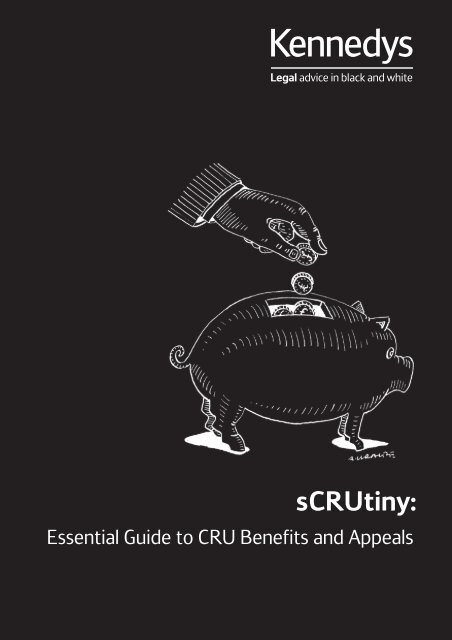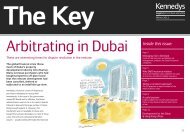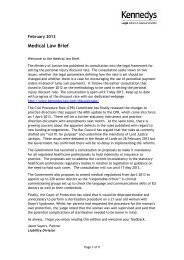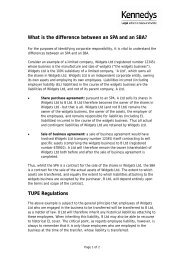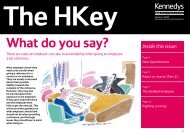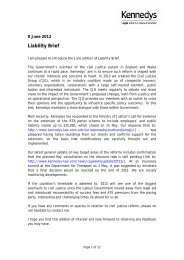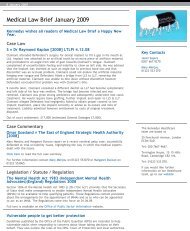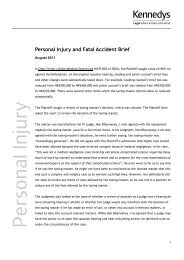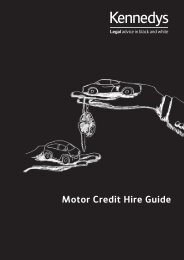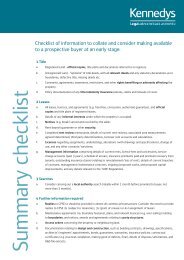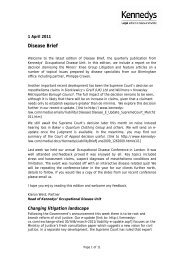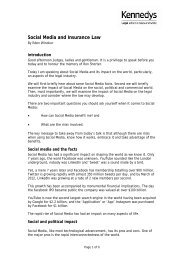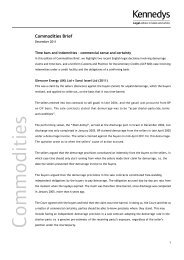Download our Essential Guide to CRU Benefits and ... - Kennedys
Download our Essential Guide to CRU Benefits and ... - Kennedys
Download our Essential Guide to CRU Benefits and ... - Kennedys
You also want an ePaper? Increase the reach of your titles
YUMPU automatically turns print PDFs into web optimized ePapers that Google loves.
s<strong>CRU</strong>tiny:<br />
<strong>Essential</strong> <strong>Guide</strong> <strong>to</strong> <strong>CRU</strong> <strong>Benefits</strong> <strong>and</strong> Appeals
Introduction<br />
In writing this guide, we had in mind a broad spectrum of readers from the novice (for whom<br />
some of this may be new) through <strong>to</strong> the more experienced h<strong>and</strong>lers who may find comfort from<br />
having a quick reference guide <strong>to</strong> the essential <strong>and</strong> key features of <strong>CRU</strong> benefits, offsetting,<br />
tactics <strong>and</strong> <strong>CRU</strong> reviews <strong>and</strong> appeals.<br />
The guide includes explanation about features of the <strong>CRU</strong> scheme which occur commonly in<br />
practice <strong>and</strong> suggestions about how these issues can be appropriately addressed.<br />
<strong>Kennedys</strong>’ s<strong>CRU</strong>tiny team has specialist expertise <strong>and</strong> an excellent track record of success in<br />
h<strong>and</strong>ling <strong>CRU</strong> benefits <strong>and</strong> NHS charges issues <strong>and</strong> advising clients on reviews <strong>and</strong> appeals.<br />
Our expertise allows us <strong>to</strong> predict with accuracy those cases which are likely <strong>to</strong> be successful <strong>and</strong><br />
those which are not, so that insurers <strong>and</strong> defendants know they are investing time <strong>and</strong> cost<br />
wisely in entrusting their <strong>CRU</strong> appeals <strong>to</strong> us.<br />
We hope you enjoy the guide <strong>and</strong> find it a useful reference <strong>to</strong>ol.<br />
Greg Woods<br />
Paul Morris<br />
<strong>Kennedys</strong> is a trading name of <strong>Kennedys</strong> Law LLP.<br />
<strong>Kennedys</strong> Law LLP is a limited liability partnership registered in Engl<strong>and</strong> <strong>and</strong> Wales<br />
(with registered number OC353214)
Contents<br />
Topic<br />
Page Number<br />
1. The starting point 2<br />
2. How much <strong>to</strong> repay <strong>and</strong> when? 4<br />
3. Offsetting 6<br />
4. Offers <strong>and</strong> settlement 9<br />
5. Reviews <strong>and</strong> appeals 11<br />
6. Notes 16<br />
7. Key contacts 17<br />
1
1. The starting point<br />
BACKGROUND<br />
• When a defendant pays damages <strong>to</strong> a claimant following a personal injury claim, benefits paid<br />
<strong>to</strong> the claimant, which are attributable <strong>to</strong> the injury, can be recovered by the DWP from the<br />
defendant (the compensa<strong>to</strong>r).<br />
• Whoever actually repays the benefits is called the “Compensa<strong>to</strong>r”. Usually, the compensa<strong>to</strong>r<br />
will be the defendant’s insurer.<br />
• The <strong>CRU</strong> (Compensation Recovery Unit) is charged with recovering such benefits from<br />
compensa<strong>to</strong>rs.<br />
• Similarly, where the NHS provides treatment <strong>to</strong> an injured claimant, the cost of this treatment<br />
is recovered by the <strong>CRU</strong> from the compensa<strong>to</strong>r.<br />
• The rules governing the recovery of benefits <strong>and</strong> the recovery of NHS charges are similar, but<br />
differ in some important respects.<br />
2
WHAT A COMPENSATOR’S REPRESENTATIVE MUST DO<br />
Complete <strong>and</strong> send a <strong>CRU</strong>1 registration form as soon as the claim is notified <strong>to</strong> them. This<br />
asks for basic details, such as the parties’ names <strong>and</strong> addresses <strong>and</strong> (except in the case of<br />
a disease claim) the names <strong>and</strong> addresses of any NHS hospitals the claimant has attended<br />
as a result of the accident or injury.<br />
The <strong>CRU</strong> registers the claim <strong>and</strong> sends a <strong>Benefits</strong> Certificate <strong>and</strong> NHS Charges Certificate<br />
if you request them <strong>to</strong> do so.<br />
Maintain a valid <strong>CRU</strong> Certificate at all times, so that you always know the benefits<br />
position (you can request a renewal up <strong>to</strong> seven days in advance).<br />
On payment of damages <strong>to</strong> the injured party, the compensa<strong>to</strong>r must repay the <strong>to</strong>tal<br />
shown on both the <strong>Benefits</strong> <strong>and</strong> NHS Charges Certificates.<br />
Seek a review of the Certificate before payment of the NHS charges, where an<br />
apportionment of liability or agreement on contribu<strong>to</strong>ry negligence has been made.<br />
Don’t be tempted <strong>to</strong> settle a claim without a valid <strong>Benefits</strong> Certificate – a previous nil Certificate<br />
is no guarantee that, on renewal, significant benefits will not be included.<br />
3
2. How much <strong>to</strong> repay <strong>and</strong> when?<br />
WHAT IS A COMPENSATOR’S LIABILITY TO THE <strong>CRU</strong>?<br />
• The <strong>CRU</strong> identifies what benefits <strong>to</strong> include in the <strong>Benefits</strong> Certificate <strong>and</strong> what NHS charges<br />
<strong>to</strong> include in the NHS Charges Certificate.<br />
• The compensa<strong>to</strong>r must repay all benefits that are both attributable <strong>to</strong> the injury <strong>and</strong> have been<br />
paid <strong>to</strong> the claimant during the “relevant period”.<br />
The relevant period<br />
Begins on the date of accident or,<br />
if a disease claim, when the claimant<br />
first claims a listed benefit in<br />
respect of that disease.<br />
Ends five years later or on payment<br />
of final damages, if sooner.<br />
Does not end at the date of agreement, order, judgment or interim payment<br />
(unless the interim payment is later accepted in full <strong>and</strong> final settlement).<br />
• Any benefits paid <strong>to</strong> the claimant outside the relevant period are not recoverable.<br />
• The compensa<strong>to</strong>r must also repay all recoverable NHS charges attributable <strong>to</strong> the injury. The<br />
amount of those charges represents only a small proportion of the actual cost of the NHS<br />
treatment received, although the recoverable amount increases every year.<br />
• The amount of repayable NHS charges crystallises when the claimant ceases receiving NHS<br />
treatment, when the case settles, or when the charges reach the maximum level set by law.<br />
4
WHEN DO BENEFITS OR NHS CHARGES NEED TO BE REPAID?<br />
<strong>Benefits</strong> <strong>and</strong> NHS charges are payable<br />
When an interim payment is made<br />
On final payment of damages in<br />
settlement of claim<br />
Note: Further benefits may continue <strong>to</strong> accrue during the relevant period even after<br />
repayment of benefits at the time of an interim payment.<br />
WHAT IF THERE IS MORE THAN ONE COMPENSATOR?<br />
• Liability <strong>to</strong> repay the <strong>to</strong>tal amount on the Certificate is joint <strong>and</strong> several. This means that each<br />
compensa<strong>to</strong>r who makes a payment of damages <strong>to</strong> the claimant is liable <strong>to</strong> repay all the<br />
benefits shown on the Certificate.<br />
• As each compensa<strong>to</strong>r may pay damages on a different date, their respective liabilities <strong>to</strong> pay<br />
benefits may be different. It is for the compensa<strong>to</strong>rs <strong>to</strong> agree an appropriate apportionment of<br />
benefits between them.<br />
• Usually, compensa<strong>to</strong>rs will repay benefits <strong>and</strong> NHS charges in the same proportion as they<br />
paid the damages, but difficulties with apportionment can arise if there are significant delays<br />
between each payment. The <strong>to</strong>tal liability <strong>to</strong> the <strong>CRU</strong> continues <strong>to</strong> accrue until the claimant’s<br />
damages are fully paid.<br />
5
3. Offsetting<br />
OFFSETTING BENEFITS AGAINST DAMAGES<br />
• Although a compensa<strong>to</strong>r is liable <strong>to</strong> repay all recoverable benefits in full, it is entitled <strong>to</strong> offset<br />
certain benefits against certain heads of damage.<br />
• Some heads of damage are un<strong>to</strong>uchable or “ring-fenced”, i.e. no benefits can be offset against<br />
them. These include damages for pain, suffering <strong>and</strong> loss of amenity (PSLA) <strong>and</strong> any future<br />
losses.<br />
Offsettable heads of damage<br />
Past loss of earnings<br />
Past care<br />
Past loss of mobility<br />
The benefits which can be offset from each head are as follows:<br />
Damages for past loss of earnings<br />
Employment <strong>and</strong><br />
Support Allowance<br />
(ESA)<br />
Jobseeker’s<br />
Allowance (JSA)<br />
Industrial Injuries<br />
Disablement<br />
Benefit (IIDB)<br />
Incapacity Benefit<br />
(IB) or Income<br />
Support (IS)<br />
Also (although much rarer): Statu<strong>to</strong>ry Sick Pay paid before 6 April 1994, Reduced<br />
Earnings Allowance, Unemployability Supplement, Unemployment Benefit, Invalidity<br />
Allowance, Invalidity Pension, Disability Working Allowance, Severe Disablement<br />
Allowance <strong>and</strong> Sickness Benefit.<br />
Damages for past care<br />
Disability Living<br />
Allowance – Care<br />
(DLAC)*<br />
Exceptionally<br />
Severe<br />
Disablement<br />
Allowance<br />
Attendance<br />
Allowance (AA)<br />
Disablement<br />
Pension increase<br />
for Constant<br />
Attendance<br />
Allowance<br />
6
Damages for past loss of mobility**<br />
Disability Living Allowance – Mobility<br />
(DLAM)*<br />
Mobility Allowance<br />
*DLAC <strong>and</strong> DLAM will soon be reformed by the DWP <strong>and</strong> will become Personal Independence<br />
Payment or PIP.<br />
**e.g. claims for wheelchairs, adapted transport, taxi or bus fares <strong>to</strong> hospital, increased cost of a<br />
car <strong>and</strong> additional holiday travel costs. Also pay special attention <strong>to</strong> the claimant’s “care claim”.<br />
Does it incorporate elements that reflect the claimant’s loss of mobility? If so, it may be possible<br />
<strong>to</strong> argue that damages paid in respect of such elements are “mobility damages”.<br />
TACTICS<br />
• As a general rule, offset as much of the recoverable benefits as you can against the damages,<br />
as this reduces the compensa<strong>to</strong>r’s overall outlay.<br />
• Unless you intend <strong>to</strong> appeal the <strong>Benefits</strong> Certificate, tactically you may decide <strong>to</strong> make a more<br />
generous allowance for offsettable heads of damage such as loss of earnings or care, where<br />
recoverable benefits exceed y<strong>our</strong> valuation of that head of loss. This will not cost the<br />
compensa<strong>to</strong>r any more money <strong>and</strong> will increase the gross value of y<strong>our</strong> offer, affording<br />
greater costs protection.<br />
For example:<br />
Care claimed:<br />
£6,000<br />
DLAC recoverable:<br />
£5,000<br />
Care valuation:<br />
£4,500<br />
Offering £5,000 for care will not cost any more <strong>to</strong> the compensa<strong>to</strong>r, will make<br />
the offer more attractive <strong>and</strong> will provide greater protection on costs.<br />
7
• However, that approach may not be advisable if you believe you have or will have grounds for<br />
reducing the benefits on the Certificate by way of review or appeal.<br />
• At trial, the c<strong>our</strong>t will scrutinise the offset of benefits made <strong>and</strong>, if benefits have not been<br />
offset properly, you may lose the protection afforded by any Part 36 or other offer made<br />
(Williams v Devon County Council [2003]). Section 8 of the Social Security (Recovery of<br />
<strong>Benefits</strong>) Act 1997 <strong>and</strong> Williams suggest this will certainly be the case where you have not<br />
offset the correct benefits against the correct heads of claim.<br />
• It may even be argued in future that an offer which offsets benefits paid outside the period for<br />
which compensation is sought is on the same principle invalid. However, the c<strong>our</strong>ts have yet <strong>to</strong><br />
address this question specifically.<br />
8
4. Offers <strong>and</strong> settlement<br />
MAKING PART 36 OFFERS<br />
• When making a Part 36 offer you are required <strong>to</strong> indicate whether the offer is made “without<br />
regard <strong>to</strong> <strong>and</strong> liability for recoverable amounts” (i.e. the figure offered is net of <strong>CRU</strong> benefits)<br />
or that the offer “is intended <strong>to</strong> include any deductible amounts” (i.e. that the figure offered is<br />
gross of <strong>CRU</strong> benefits <strong>and</strong> so, if accepted, the Claimant will receive the sum offered less<br />
offsettable benefits). (CPR 36.15(3)<br />
• If an offset is <strong>to</strong> be made you must:<br />
Apply first for a <strong>Benefits</strong> Certificate.<br />
Specify the gross amount of the offer (before offset of benefits).<br />
Specify the amount of offset made, specifically the name <strong>and</strong> amount of the benefit offset.<br />
Specify the net amount left after offset of benefits.<br />
• Where you are without a valid Certificate, but have applied for one, refer <strong>to</strong> CPR Part<br />
36.15(7). This enables you <strong>to</strong> make an offer, but <strong>to</strong> reserve the right <strong>to</strong> offset benefits once<br />
you receive the Certificate. To preserve the effective start date of y<strong>our</strong> Part 36 offer, you<br />
must clarify the amount of offset of benefits within seven days of receiving a new Certificate.<br />
If accepted, calculation of the net damages will of c<strong>our</strong>se be delayed until the Certificate is<br />
available.<br />
• Where benefits have increased since making a Part 36 offer <strong>and</strong> the “relevant period” for<br />
accepting the offer has expired, the c<strong>our</strong>t’s permission will be needed <strong>to</strong> accept a Part 36<br />
offer, unless the compensa<strong>to</strong>r agrees. The c<strong>our</strong>t may reduce the net amount due <strong>to</strong> the<br />
claimant, so increasing the amount of the offset <strong>to</strong> take in<strong>to</strong> account the increased benefits<br />
the compensa<strong>to</strong>r will have <strong>to</strong> repay (CPR Part 36.15(9)).<br />
• Consider whether an appeal against the benefits or NHS charges will be feasible at the start of<br />
the case, not as an afterthought or when settlement is made. This enables you <strong>to</strong> obtain<br />
sufficient evidence, e.g. by asking questions of the medical expert in support of the appeal<br />
before settling the claim, when it may be <strong>to</strong>o late.<br />
9
CONSENT ORDERS/TOMLIN ORDERS IN SETTLEMENT OF A CLAIM<br />
• When making any offer <strong>and</strong> drafting a consent or Tomlin order be clear <strong>and</strong> specific about<br />
which benefit is being offset against which head of damage, <strong>and</strong> the amount being offset,<br />
e.g. £1,000 ESA against loss of earnings.<br />
• Ensure the order makes clear the gross sum offered, the amount of benefits offset <strong>and</strong> against<br />
what element of damages, <strong>and</strong> the net amount after offset of benefits.<br />
• In consent or Tomlin orders, avoid ambiguous phrases, which suggest an offset has been<br />
made, such as “net of benefits” <strong>and</strong> “plus benefits”. It is always preferable <strong>to</strong> state the gross<br />
settlement figure so that there can be no misunderst<strong>and</strong>ing as <strong>to</strong> the amount offset from<br />
damages, particularly if you are contemplating an Appeal <strong>and</strong> you are unable <strong>to</strong> offset all of<br />
the repayable benefits from the Claimant’s damages.<br />
• Where no offset is made, don’t use “net” or “gross” etc, simply use “in full <strong>and</strong> final<br />
settlement”.<br />
• The order does not need <strong>to</strong> specify that the compensa<strong>to</strong>r repays the benefits. The obligation<br />
<strong>to</strong> pay is governed by statute.<br />
10
5. Reviews <strong>and</strong> appeals<br />
SEEKING A REVIEW OF A BENEFITS CERTIFICATE<br />
• A review is a request from a compensa<strong>to</strong>r or claimant <strong>to</strong> the <strong>CRU</strong> <strong>to</strong> change the period or<br />
amount of benefits shown on a certificate.<br />
• A review can be requested in writing at any time, but only once per Certificate.<br />
• You should set out succinctly why the Certificate is wrong or the benefits or some of them<br />
should not be included.<br />
• Send the <strong>CRU</strong> any medical evidence <strong>and</strong> refer them <strong>to</strong> the key points.<br />
The grounds for review (where a review will succeed) are where:<br />
The <strong>CRU</strong> has made an obvious mistake<br />
in the preparation of the Certificate.<br />
The amount of benefits on the<br />
Certificate is wrong.<br />
• Whilst the grounds for review are fairly restricted, it is worth requesting a review even in<br />
reliance on a ground of appeal as the <strong>CRU</strong> will sometimes review the benefits position on a<br />
broader (appeal) basis.<br />
• Don’t be put off appealing benefits on the same grounds/in reliance on the same evidence<br />
where a review fails, as the grounds of appeal are broader. A valid appeal often succeeds<br />
where a review has failed. Also, it is always possible that the Appeals Tribunal will reach a<br />
different conclusion <strong>to</strong> that reached by the <strong>CRU</strong> under the Review process.<br />
APPEALING A BENEFITS CERTIFICATE<br />
• An appeal is heard by the Appeals Tribunal, not the <strong>CRU</strong>. The appeal papers are initially filed<br />
with the <strong>CRU</strong> however.<br />
• An appeal is made by a compensa<strong>to</strong>r <strong>to</strong> the <strong>CRU</strong> <strong>to</strong> have one or more benefits removed<br />
entirely or <strong>to</strong> have the period or amount of benefits shown on a certificate reduced.<br />
• An appeal can only be brought after settlement of the claim <strong>and</strong> repayment of benefits in full.<br />
• The appeal hearing is chaired by a Tribunal Chairperson who will be a qualified lawyer. The<br />
Chairperson will typically be assisted by a medical expert. The Tribunal may reach a decision<br />
11
y consideration of the papers only, or following an oral hearing. If the latter, the Tribunal will<br />
hear submissions from both the DWP <strong>and</strong> the Compensa<strong>to</strong>r’s representative before reaching a<br />
decision.<br />
• You will be asked if you require an oral hearing. Oral hearings are preferable if the sums<br />
involved are more than trivial.<br />
The time limit for an appeal is one month from payment of benefits.<br />
• There are only very limited circumstances where an appeal can still be made after this time.<br />
This relies upon the goodwill <strong>and</strong> discretion of the tribunal in permitting the appeal <strong>to</strong><br />
continue.<br />
The grounds for an appeal against the <strong>Benefits</strong> Certificate are that:<br />
The amount, rate or period of benefits<br />
shown on the Certificate is wrong.<br />
The Certificate shows benefits not paid as<br />
a result of the accident, injury or disease.<br />
<strong>Benefits</strong> have been included <strong>to</strong> which the claimant should not have been entitled at all.<br />
• The accident or injury need not be the only, but must be a significant cause of the claimant<br />
receiving benefits for the benefits <strong>to</strong> be recoverable from the compensa<strong>to</strong>r.<br />
• If the relevant accident or injury is not an effective or significant cause of the payment of<br />
benefits, e.g. it did not change the claimant’s pre-existing disability or restrictions, an appeal<br />
has a good chance of success.<br />
• If y<strong>our</strong> evidence is supportive <strong>and</strong> there is a valid reason <strong>to</strong> prefer y<strong>our</strong> evidence, an appeal is<br />
viable. You do not need overwhelming evidence <strong>to</strong> succeed with an appeal. It is assessed on<br />
the balance of probabilities.<br />
• You are obliged <strong>to</strong> submit all medical evidence exchanged in the case with y<strong>our</strong> appeal<br />
(not just fav<strong>our</strong>able evidence), <strong>to</strong>gether with Statements of Case, Schedule of Loss/Counter-<br />
Schedule, witness evidence <strong>and</strong> any other relevant evidence.<br />
• The most common ground of appeal is that the period of accident-related symp<strong>to</strong>ms ended<br />
prior <strong>to</strong> the relevant period, for example an acceleration case where the period of acceleration<br />
terminated prior <strong>to</strong> the end of the relevant period.<br />
12
• The <strong>CRU</strong> Review Section will consider an appeal <strong>and</strong> may make a partial refund or change the<br />
<strong>Benefits</strong> Certificate. If you are not satisfied with their response, you must notify them within<br />
one month. The <strong>CRU</strong> will then prepare their submission <strong>and</strong> send appeal papers <strong>to</strong> the<br />
Tribunals Service <strong>to</strong> arrange the oral hearing.<br />
SEEKING A REVIEW OF AN NHS CHARGES CERTIFICATE<br />
• An NHS Charges review is a request from a compensa<strong>to</strong>r <strong>to</strong> the <strong>CRU</strong> <strong>to</strong> change the period or<br />
amount of NHS charges shown on a Certificate.<br />
• A review is requested in writing.<br />
The time limit for a review of the NHS Charges Certificate is at any time before<br />
settlement or within three months of payment of damages <strong>to</strong> the claimant<br />
or later receipt of an NHS Charges Certificate.<br />
• You should set out succinctly why the Certificate is wrong or the NHS charges or some of<br />
them should not be included.<br />
• Send the <strong>CRU</strong> any medical evidence <strong>and</strong> refer them <strong>to</strong> the key points.<br />
A review will succeed where:<br />
There is an obvious mistake in the<br />
preparation of the Certificate.<br />
The amounts of charges on the<br />
Certificate are <strong>to</strong>o high.<br />
A ground of appeal is satisfied.<br />
• Don’t be put off appealing NHS charges where a review fails on the same grounds/on the<br />
same evidence, as the grounds of appeal are broader. A valid appeal often succeeds, where a<br />
valid review has failed.<br />
• Remember that an appeal is heard by an independent Appeals Tribunal.<br />
13
NHS CHARGES AND CONTRIBUTORY NEGLIGENCE: WHAT CAN YOU DO?<br />
• Unlike with recoverable benefits, a finding of contribu<strong>to</strong>ry negligence will reduce the NHS<br />
charges payable, e.g. a finding of 25% contribu<strong>to</strong>ry negligence will reduce the NHS charges by<br />
25%.<br />
• This may make securing a finding of contribu<strong>to</strong>ry negligence very beneficial. Even where a<br />
global settlement can be achieved, if the NHS charges are significant, it is worth pushing y<strong>our</strong><br />
opponent for a finding of contribu<strong>to</strong>ry negligence.<br />
• A reduction in the NHS charges due <strong>to</strong> a finding of contribu<strong>to</strong>ry negligence is achieved by<br />
seeking a review on grounds of contribu<strong>to</strong>ry negligence of the NHS Charges Certificate after<br />
settlement of the case but before payment of NHS charges. You must send <strong>to</strong> the <strong>CRU</strong><br />
evidence of the liability split.<br />
• The <strong>CRU</strong> will only consider a review on grounds of contribu<strong>to</strong>ry negligence after settlement of<br />
the whole case (liability <strong>and</strong> damages).<br />
• You do not need <strong>to</strong> pay the NHS charges before seeking a review on grounds of contribu<strong>to</strong>ry<br />
negligence.<br />
A review request on grounds of contribu<strong>to</strong>ry negligence must be made within three<br />
months of payment of damages.<br />
• If accepted, the <strong>CRU</strong> will send a revised Certificate, showing the reduced amount of NHS<br />
charges payable. It is acceptable <strong>to</strong> calculate the revised amount of NHS charges <strong>and</strong> send a<br />
cheque for that sum, <strong>to</strong>gether with <strong>and</strong> in anticipation of a successful review request.<br />
NHS CHARGES AND MULTIPLE DEFEFNDANTS<br />
• Unlike benefits, but in a similar way <strong>to</strong> contribu<strong>to</strong>ry negligence, NHS charges can be<br />
apportioned between compensa<strong>to</strong>rs (co-defendants) provided that the <strong>CRU</strong> is provided with<br />
evidence <strong>to</strong> reflect the liability agreement reached between the defendants.<br />
14
APPEAL OF AN NHS CHARGES CERTIFICATE:<br />
• An appeal of NHS charges can be made by a compensa<strong>to</strong>r <strong>to</strong> the <strong>CRU</strong> <strong>to</strong> have one or more<br />
elements of the NHS charges removed entirely or <strong>to</strong> have the period or amount of charges<br />
shown on a Certificate reduced.<br />
• This can only be made after settlement <strong>and</strong> payment of NHS charges.<br />
The time limit for an appeal of NHS charges is three months from payment of<br />
damages or later receipt of an NHS Charges Certificate.<br />
• There are very limited or special circumstances where an appeal can still be made after this<br />
time <strong>and</strong> this relies upon the goodwill <strong>and</strong> discretion of the tribunal in permitting the appeal <strong>to</strong><br />
continue. This is subject <strong>to</strong> a one year long-s<strong>to</strong>p after which an appeal will be refused outright.<br />
The main grounds for an appeal against the NHS Charges Certificate are that:<br />
The amount of the NHS charges is incorrect.<br />
It includes non-NHS hospital treatment<br />
charges or charges not as a result of an<br />
accident or injury, e.g. treatment received<br />
for other reasons.<br />
• It would be a valid ground of appeal <strong>to</strong> demonstrate that the claimant would have received the<br />
treatment <strong>and</strong> therefore incurred the NHS charges irrespective of the accident.<br />
15
Notes<br />
16
Key contacts<br />
Greg Woods<br />
Partner<br />
Sheffield<br />
Telephone: +44 114 253 2078<br />
g.woods@kennedys-law.com<br />
Paul Morris<br />
Solici<strong>to</strong>r<br />
Birmingham<br />
Telephone: +44 121 214 8027<br />
p.morris@kennedys-law.com<br />
17


